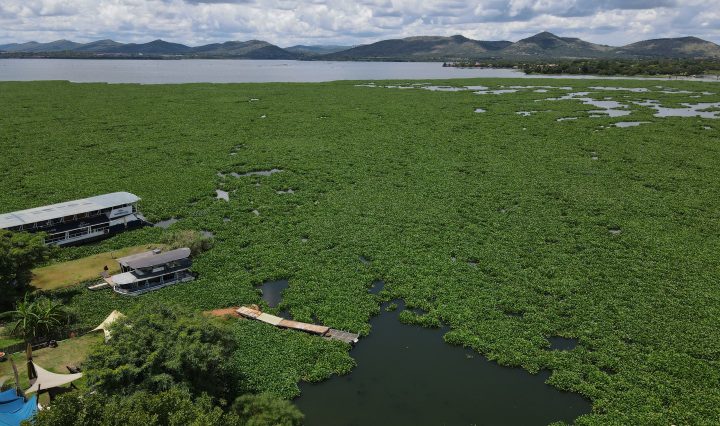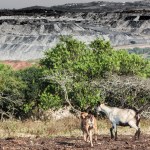TOXIC INC
Harties vs the hyacinth (Part 1) – The toxic dangers lurking under cover of an invasive weed

Hartbeespoort Dam’s water hyacinth problem is creating a breeding ground for toxic algal blooms that could result in liver and neuro-toxins in humans, should the hyacinth overgrowth continue unaddressed, studies confirm.
Uncontrolled hyacinth covering large parts of the Hartbeespoort dam is an eyesore for residents of the area, but beneath the surface lurks an even greater threat.
Recent studies have shown that increased nutrients in the water – either from excessive sewage inflows or rotting plant (hyacinth) matter – has increased the presence of microcystis blooms in the dam. Microcystin is a cyanotoxin (a toxic bacteria) that can get into drinking water when wastewater facilities are not properly equipped to remove the bacteria; it can cause severe health effects in humans and animals.
A study, by the Tshwane University Of Technology (TUT), investigated the effects of cyanobacteria in samples of water sources and containers from near the Hartbeespoort Dam. Microcystins were present in the water used by communities around the dam, both in communal tap water and in water stored in tanks; this being water supplied from Hartbeespoort Dam, and considered to have gone through the purification process. Although the microcystin was found to be below acceptable limits, it was suggested that the water be treated before storage.
Water hyacinth – scientific name Pontederia crassipes – is an invasive species in South Africa, with its roots native to the Amazon Basin. The aquatic plant, which sprouts pastel purple flowers from its shiny dark green leaves, feeds off nutrient-dense waters doubling itself within 5–15 days; its rapid growth has some small positive gains, but it has had mainly negative effects for the Hartbeespoort Dam, which is drenched in sewage waste.
First discovered in South African waters around the early 1900s in the Cape area, water hyacinth has since spread across the country’s dams, reproducing its seeds in various water bodies in the Western Cape, KwaZulu-Natal, Gauteng, Free State and Mpumalanga. The most affected region however is across the Vaal.
And one of the most affected dams in the region is the Hartbeespoort Dam.
The dam is fed by the Crocodile River, which has its origins in Gauteng, flowing through Johannesburg and Tshwane along the way and carrying with it sewage from informal communities and broken treatment works. Tributaries feeding the Crocodile include the Magalies, Leeuwspruit and the Swartspruit rivers – all of which carry nutrient-rich waste in their streams.
More than 700 megalitres of treated sewage is poured into the dam per day, resulting in more than 450+ tonnes of phosphates (mainly found in detergents and other hygiene products) per annum. These phosphates create the perfect conditions for water hyacinth to grow.
But this is not a new problem, as efforts by the Department of Forestry, Fisheries and the Environment (DFFE) to bring the growth under control over the past two decades attest.
“The DFFE has appointed Expanded Public Works Programme teams to manually remove the macrophytes. There are 10 teams on Hartbeespoort Dam manually removing the water hyacinth. Their last contracts were paid in December 2022 and are currently in the process of RFQs (request for quote),” Albi Modise, now the DFFE’s former chief communications officer, told Daily Maverick.
Modise, who spoke to Daily Maverick while he was still with DFFE, added that the department runs a biocontrol programme at the dam, in partnership with the Rhodes University’s Centre for Biological Control. In the project, biocontrol agents in the form of alien bugs from South America are released into the hyacinth-covered water from three points around the dam.
Though the biocontrol measure has provided some relief to dam coverage by hyacinth, the alien bugs have created another issue that could breed a liver carcinogen.
Attacking the symptom
Aquatic ecologist Liz Day told Daily Maverick that 10 wastewater works fed into the dam’s catchment area, which increased the nutrient content of the water. And while the insects were providing a solution, they were only attacking the symptom.
“The insects eat the hyacinth, sinking the hyacinth. But that’s creating more nutrients when the plant matter decomposes, [creating a] cycle of ever-increasing nutrients.
So while the bugs are good for addressing the impact of a lack of open water surface on recreation, they do not solve the high nutrient content problem, Day said.
Wisane Mavasa, Department of Water and Sanitation (DWS) spokesperson, told Daily Maverick that plant nutrients are excessive at the dam.

The Hartbeespoort Dam was more than 60% covered in hyacinth from the beginning of 2023. Photo: Julia Evans
Mavasa said that along with excessive plant nutrients (plant decay) at the dam, sediment layers making up more than 20% of the dam storage capacity have built up over the dam’s 100 years of existence. She added that the active top sediment layer and declining aquatic filters of the dam’s ecosystem are the main cause of its hyper-nutrients.
Day said the real issue with a lot of local dams is wastewater treatment works that flow into water bodies and create a well-fertilised system that forms the perfect breeding ground for invasive species.
Retired chemical engineer and Hartbeespoort resident Frederick Botha told Daily Maverick that in addition to the dam’s ecological woes there is the strain of waste from informal developments along the dam’s catchment areas.
Botha said that the waste from growing informal settlements adds to a deadly bacteria that is prevalent along the shallow edges of the dam. The engineer described how rotting hyacinth caused by biocontrol agents eating at the invasive plant results in fermentation.
He explained that in areas where there’s more hyacinth and, as a result, less light penetrating the waters, a slow fermentation process takes place, releasing methane.
A Marine and Freshwater Research study recalled a cattle die-off on the shores of the dam in the early 1970s, that was related to toxins produced by algal blooms. Later studies following the incident found that there were more variants of the cyanobacteria toxin, and that the number had been underestimated due to focus on other bacteria.
Toxic algal blooms
Tourism operators who rely on the dam for tourist activities have considered spraying herbicide to kill the hyacinth, but Mavasa said this is not an option as the chemicals would cause a rapid hyacinth to die-off and exacerbate algal blooms.
“One thing that you must understand is that herbicides can contain glyphosates or Roundup; and that is a potential liver carcinogen,” Botha said.
Blue-green algae, or cyanobacteria, generally exist within water bodies, but the excessive presence of the water hyacinth and its fermenting at the bottom of the dam contribute to algal blooms.
Botha explained that a thick layer of scum caused by the fermentation blocks the oxygen that the bacteria need to survive, resulting in the bacteria killing each other. This continuous rot due to the lack of oxygen creates microcystin.
Microcystin, a cyanotoxin, can get into drinking water when wastewater facilities are not properly equipped to remove the bacteria. According to Botha, the TUT study that he supervised found that attempts by a wastewater facility to clear the water of microcystis by using chlorine reacted and created trihalomethane, a carcinogen dangerous to both humans and animals.
For now, regular water tests done by the Institute for Water Quality Studies have not raised any health regulation flags.
Blessing in disguise
For Botha, no single solution is sufficient to address the hyacinth problem. He’s studied the dam for about 20 years, trying to understand its biological ins and outs. He says an integrated approach ensures a continuously healthy dam.
“Hyacinth is a blessing in disguise; but it is only a blessing in disguise (as a natural filtration system) if you can control it. And you must have an integrated approach; mechanical, biological and chemical removal – and that is a very sophisticated process.” DM



















 Become an Insider
Become an Insider
Comments - Please login in order to comment.